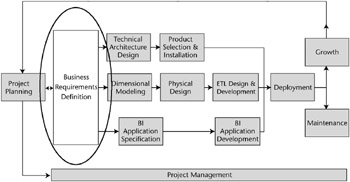Chapter 1: Defining Business Requirements
| | ||
| | ||
| | ||
Building the foundation
Overview
Business requirements are the bedrock of the DW/BI system. Business requirements guide the development team in making the biggest strategic choices, such as prioritizing subject areas for implementation, and in making the smallest tactical design decisions, such as how to present key performance indicators on the users screens. In this chapter, we cover the process of gathering business requirements and converting them into a DW/BI system strategy. We describe the process of interviewing business and IT representatives, categorizing their requirements into analytic themes, converting those themes into incremental projects, and working with senior management to prioritize those projects. We also include a partial set of example requirements for the Adventure Works Cycles business.
As Figure 1.1 illustrates, the Business Requirements Definition is the foundation of the Lifecycle methodology. Business requirements and their associated business value give you the guidance you need to make decisions in all three downstream tracks. As youll see, they influence the project scope and plan as well.

Figure 1.1: The Business Requirements Definition step of the Business Dimensional Lifecycle
This chapter is primarily about resisting temptation. Gathering business requirements is often outside a technical persons comfort zone. The overall success of the project is largely determined by your understanding of the business requirements and your relationships with the business people. Resist the temptation to just start loading data.
In this chapter you learn the following:
-
The importance of understanding business requirements and securing solid business sponsorship
-
How to define enterprise-level business requirements, including the interview process, developing analytic themes, linking themes to business processes, developing the data warehouse bus matrix, and prioritizing business processes with senior management
-
How to plan the initial business process dimensional model implementation and gather project-level business requirements
-
What a typical requirements summary document looks like and how it links to analytic themes and business process implementations
| | ||
| | ||
| | ||
EAN: N/A
Pages: 125